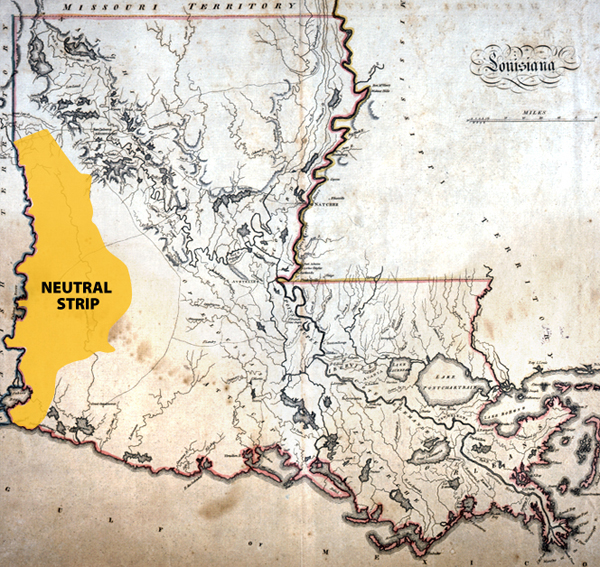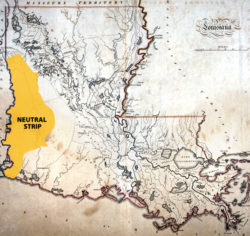Neutral Strip
The Neutral Strip existed outside the governance of either the United States or Spain until 1821.
This entry is 7th Grade level View Full Entry

Louisiana State Museum
This map from 1814 shows Louisiana with the Neutral Strip highlighted.
What was the Neutral Strip?
The Neutral Strip, sometimes referred to as No Man’s Land or the Neutral Ground, was a disputed area lying between Spanish Texas and the newly American territory of Louisiana. In October 1806 American and Spanish armed forces faced each other at the Sabine River. To avoid war General James Wilkinson, in command of American forces, and Lieutenant Colonel Simón de Herrera, commanding for Spain, reached a temporary compromise known as the “neutral ground agreement.” If Herrera kept Spanish forces west of the Sabine River, Wilkinson would withdraw American troops to the east of the traditional French/Spanish boundary. The Neutral Strip was formalized in writing, so neither government would attempt to take control, send troops into the neutral territory, or let anyone enter until a formal international boundary was established. The neutral ground operated without either American or Spanish governance until 1821.
Why were the boundaries of the Louisiana Purchase difficult to define?
After the United States acquired Louisiana from France, a dispute over the exact boundaries of the Louisiana Purchase brought Spain and the United States to the brink of war. Americans headed to the western portion of the Territory of Orleans and claimed Texas as part of the purchase. This claim threatened the sparsely populated and poorly defended Spanish province. At the same time, tensions over relations with Native Americans and the Spanish practice of protecting people who fled slavery in the United States made war seem likely. Each side sent men to the border in the belief that invasion by the other was imminent.
The confusion over the official boundary between Louisiana and Texas stemmed from Spain and France’s failure to officially settle the issue before the 1763 transfer of Louisiana from France to Spain. Instead, a Spanish commander and the French commandant at Natchitoches had reached a gentleman’s agreement with a vague dividing line that ran up from the Gulf of Mexico, between the Calcasieu and Mermenteau Rivers, to the Arroyo Hondo, then north to the vicinity of Natchitoches and up the Red River. When France ceded Louisiana to Spain, Spain accepted the dividing line between Louisiana and Texas. After the United States purchased Louisiana, American officials, including President Thomas Jefferson, argued that the Rio Grande constituted the boundary of the Louisiana Purchase, which included the province of Texas. Many Americans, wanting more territory, supported this claim.
What were the effects of the neutral ground agreement?
The neutral ground agreement wasn’t a solution to the boundary issue. Yet, since there was no international treaty, it did help relations between Spain and the United States. In the broader context of relations between nations, the compromise displayed the important role the Louisiana-Texas borderlands played in reshaping political and diplomatic practices. Leaders on both sides of the Sabine River were able to find peaceful solutions to several critical issues. International diplomacy failed, but local diplomacy worked. By shifting the focus of negotiations from the Rio Grande to the Sabine, Wilkinson and Herrera also stopped any attempt by the United States to include Texas as part of the Louisiana Purchase. Most importantly, both the United States and Spain accepted the agreement, which reopened diplomatic talks.
Although the neutral ground agreement prevented war, it destabilized the region for more than a decade. Americans began moving into the area almost immediately after the zone became demilitarized. Runaway slaves, deserters from both armies, thieves preying on the trade along the Camino Real (Royal Road), and criminals found this region—outside of the control of governments or law—an ideal refuge. As the number of bandits grew, trade along the Camino Real suffered. Merchants in Natchitoches and Nacogdoches complained to local officials. Some Americans were unhappy with the exclusion of Texas from the Louisiana Purchase and the possibilities of having an empire as a neighbor. The area became a staging ground for demonstrations and protests. After revolution broke out throughout Spain’s colonial empire in the Americas, Americans eager to go to war with Spain invaded Spanish territories. For people on both sides of the neutral strip, these conflicts brought death, destruction, and economic hardship.
How did Spanish and American forces work together?
By 1808 military leaders on both sides of the Sabine River knew that action had to be taken to bring stability to the area. After receiving approval the US military sent fifteen men, under Lieutenant William Augustus Magee, into the neutral ground. There they met the commandant of Spanish Nacogdoches, José María de Guadiana, and an equal number of Spanish troops. Together, this combined force drove the squatters, bandits, and deserters out of the neutral ground. Over two weeks the combined force destroyed a dozen buildings and made thirty-four people leave.
As soon as the combined force left the neutral ground, those who were removed came back. By early 1812 the problem again required action. In the Territory of Orleans, General Wade Hampton sent Lieutenant Colonel Zebulon Pike to Natchitoches to contact the Spanish at Nacogdoches and form another joint expedition to clear unauthorized people from the region. The Spanish commandant, uncertain of his authority, replied that he’d contact the provincial governor for permission. Pike wasted no time in informing the Spanish officer that, with or without Spanish cooperation, he intended to send an American force into the neutral ground.
On March 5, Pike ordered William Augustus Magee, into the neutral strip. The expedition destroyed eleven houses along with various tent camps. In the process, they captured sixteen men and thirty-five horses and mules and recovered stolen merchandise, arms, and ammunition. This violation of the neutral ground agreement ended Spanish–American cooperation along the borders of Texas and Louisiana. The US government shifted its focus to the war with the British.
What were the long-term effects of the neutral ground agreement?
The neutral ground influenced the boundaries set up by the Adams-Onís Treaty of 1819, which was ratified in 1821 and is also known as the Transcontinental Treaty. Article II of the Adams-Onís Treaty of 1819 transferred all Spanish lands east of the Mississippi, specifically East and West Florida, to the United States. Article III of the treaty established the western boundary of the United States—eliminating the neutral strip—at a line beginning at the mouth of the Sabine River, continuing up the river’s west bank north to the Red River, then following the west bank of the Red River to Arkansas. This treaty temporarily halted American claims to Texas territory.
